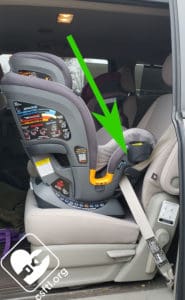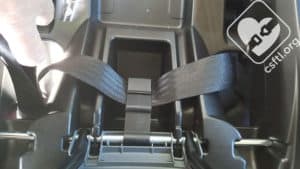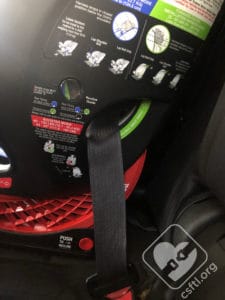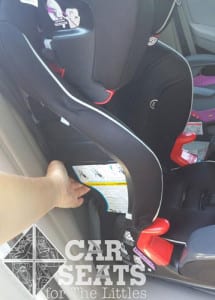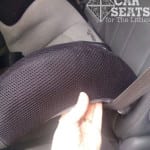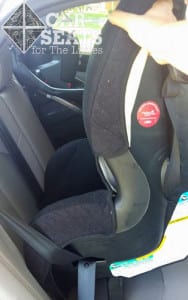“You want less than one inch of movement when you give it a firm handshake at the belt path with your non dominant hand.”
I have said that statement many times to parents and caregivers. It’s one of those times where I wish English had a few more words so I could describe that in the same detail, but with less verbosity.
What does it mean, though? Let’s go through it a bit at a time.
Checking for Movement at the Belt Path
Any car seat that is installed (versus a booster seat that is just sitting on the vehicle seat) has at least one belt path. That’s the location in the vehicle where the seat belt or lower anchor webbing will go. Sometimes they’re clearly labeled and obvious; other times they’re more subtle. They’re always there, though.
A rear facing only infant car seat has one belt path on the base and another belt path on the seat itself for installing it without the base (check your car seat manual — some require a base after a certain weight).
A convertible car seat has two belt paths; one under the legs for rear facing installations and one roughly behind the back for forward facing installations.
A forward facing only combination seat has one belt path located behind the child’s back.
When I check for movement at the belt path of a seat, I want to grab where I’ve put the seat belt or lower anchor strap through, or as close to it as possible. Then, just as if I’m meeting a prospective boss for the first time, give a firm handshake. I don’t need both hands or to rock it as hard as I can. I want to give a firm, not noodly, handshake. Back and forth and front to back.
What’s My Nondominant Hand?
My nondominant hand is my weaker hand. For most people this means the left hand. For lefties, this is probably the right hand. I don’t even need to push the seat with my strongest hand.
Where Not to Check for Movement
I don’t need to check for movement at the head of a forward facing seat after I’ve added the top tether, either. Any movement there is fine, provided the slack from the tether has been removed as best as I can. The tether should be connected after the seat has been tested for movement and found acceptable. I cannot remove movement from the belt path by stabilizing it with the tether.
If I have less than 1 inch of movement in any direction at the belt path when I check with a firm handshake, I have a successful installation. It really doesn’t matter how much movement there is at the top of the seat, or at the front. Nor does it mean I should get a better install so that I can’t move the seat at all if I shove it hard with both hands.
I’ve demonstrated proper installations to parents and then shown them how, with my feet braced, both hands on the seat, and shoving hard, I can move the seat six inches. I’ve also tipped a rear facing seat all the way forward so that it touches the backseat. These are not reasons for concern.
The seat meets or exceeds very stringent testing when installed with up to 1 inch of movement at the belt path.
Over Tightening and Under Tightening
There are also risks to both over tightening and under tightening.
If I under tighten the car seat, the risks are pretty clear. The seat will not perform as well as a properly installed seat in a crash, and the child could be at increased risk of injury or death due to impact injuries with other objects in the car. This is a video from the University of Michigan Transportation Research Institute (UMTRI) showing a properly installed seat in the foreground, and a seat that has been installed too loosely in the background.
To over tighten a car seat, I’d have to add either added a ratcheting tightener, use my full body weight, or use multiple people to install the seat. This risks over stressing not only the seat, but the lower anchor strap or seat belt as well.
Everything in a crash that is there to protect your child actually moves during a crash. The seat moves, the lower anchor strap or seat belt stretches, even the harness holding the child stretches. This is a very good thing. Imagine the difference between landing on a soft mattress and landing on a bed of rocks. The mattress moves and I move more slowly to a stop. When I jump on the bed of rocks, nothing stops me but the rocks, and it’s a sudden and painful stop. If we remove the ability to stretch and move, by practically welding the seat to the car, you may again have increased the chances of injury or death to your child. Not to mention, two full-grown adults pushing hard to install a seat meant for a child under about 65 pounds can simply damage the seat. The majority of seats can be installed properly by a petite person without assistance. I’m 5 feet 1 inch tall and can install nearly every seat on my own. I’ve had petite women in the past tell me there’s no way they could install their seats, it took two 300 pound firemen. I’m sure they weren’t encouraged upon seeing me, at first. But by the time they left they were masters of their seats.
I have gotten a rock solid install, by myself, with just my normal added weight and pulling tight. Don’t fret. It’s fine to have a rock solid install provided nothing extreme was done to get it. Some seats just simply install that way with little effort.
Conclusion
In the end remember, when checking your installation, just use a firm handshake at the belt path and look for up to 1 inch of movement. If the seat moves less than that inch, and you followed the directions in your vehicle and car seat manuals, you’ve probably got a proper install. Seeing someone in person is never a bad idea as well. Find a certified CPST near you!


